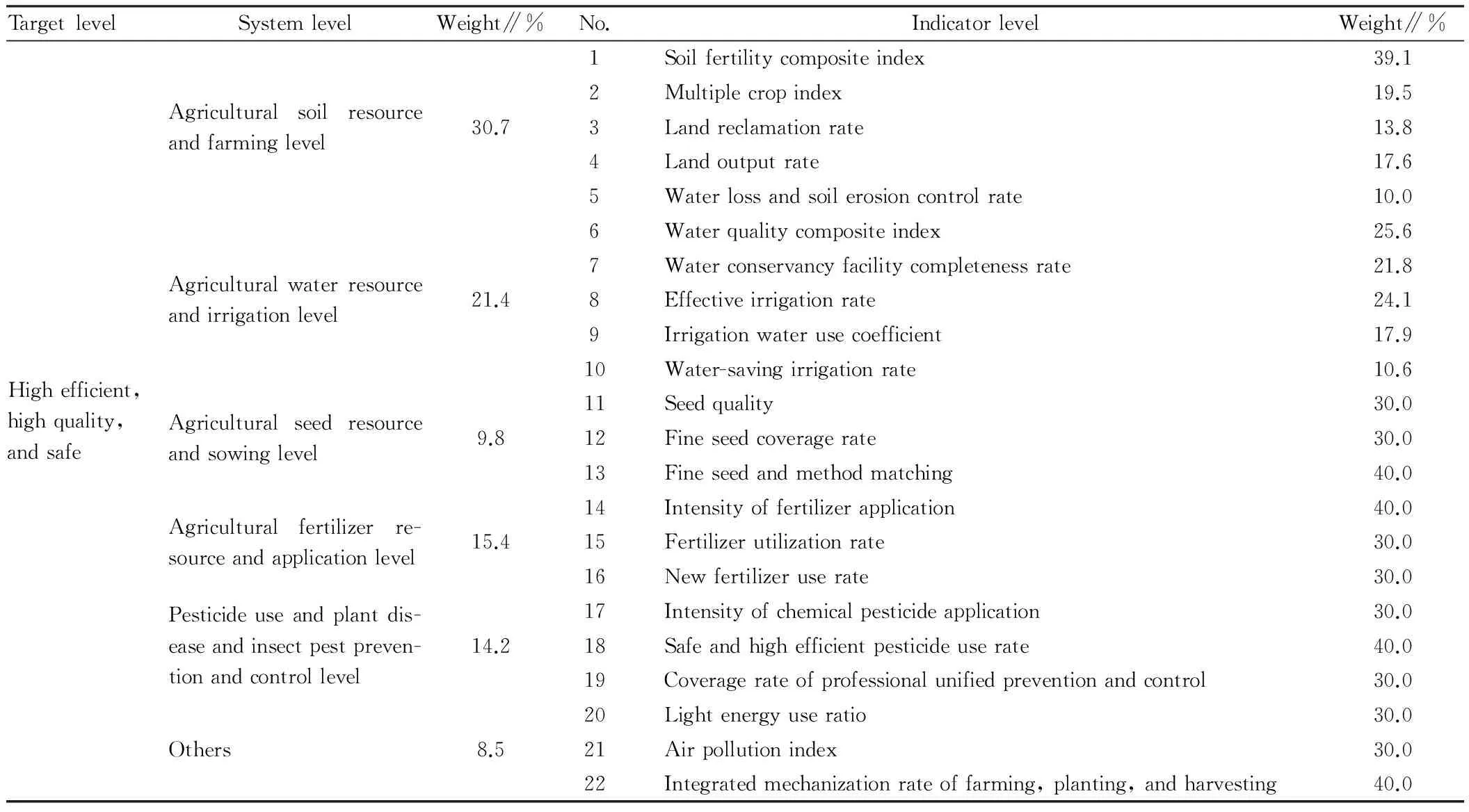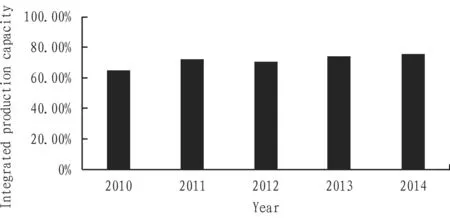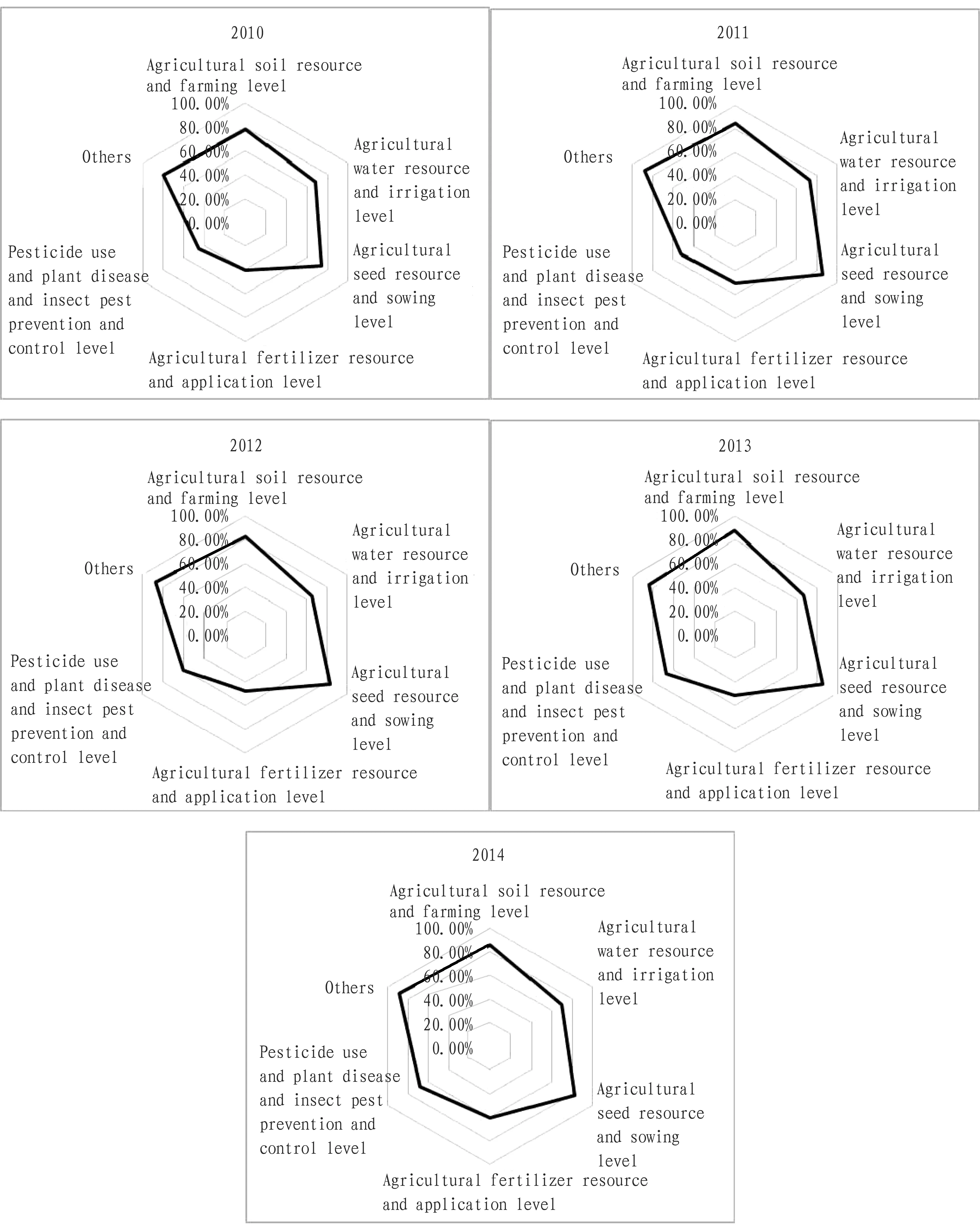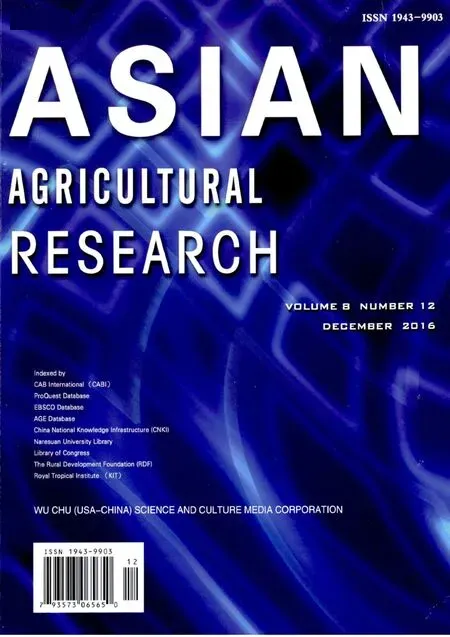Evaluation of Integrated Production Capacity of Well-facilitated Farmland in Jiangsu Province
School of International Pharmaceutical Business, China Pharmaceutical University, Nanjing 211198, China
1 Introduction
Farmland is an essential material base of agricultural production. Long time of scientific research observation indicates that farmland with high fertility has contribution rate up to 60%-70% to the grain yield, while farmland with low fertility has only 40% contribution rate to the grain yield[1-3]. At present, China’s agricultural modernization is excessively dependent on chemical fertilizer, pesticide and antibiotic due to influence of industrial pollution; farmland pollution is increasingly deteriorating; farmland quality is not optimistic; all of these are threatening quality and safety of agricultural products[4-7]. Traditional farmland capital construction mainly solves external project conditions, but this could not completely solve existing problems in improvement of farmland quality. On June 13, 2014,RulesofWell-facilitatedFarmlandConstructionwas issued by General Administration of Quality Supervision, Inspection and Quarantine and Standardization Administration and formally implemented on June 25, 2014. According to this standard, the well-facilitated farmland is farmland divided into permanent capital farmland with level land, concentrated, well facilities, fertile soil, excellent ecology, and high anti-disaster ability. Well-facilitated farmland is quintessence of farmland. Developing well-facilitated farmland plays a great role in increasing farmland area, improving farmland quality, and ensuring balance in requisition and compensation. Well-facilitated farmland construction focuses on intrinsic quality construction. It is an essential means for increasing grain yield, farmers’ income, and promoting stable development of agriculture. Jiangsu Province is a large province of grain production, and its land resources are mainly plain with excellent natural properties, deep soil layer and high and medium fertility, suitable for farming. At present, the farmland protection area of Jiangsu Province reached 69 million mu, accounting for more than 80% of agricultural land. However, the per capita farmland is less than 0.9 mu, far lower than the average national level. Land load rate and output rate are high, but the reserve resources are insufficient, thus the demand for well-facilitated farmland construction is urgent in Jiangsu Province. In 2014, Jiangsu Province drafted thePlanforWell-facilitatedFarmlandConstructioninJiangsuProvince(2014-2020), which set forth construction criteria for well irrigating facilities, level and fertile farmland, smooth field roads, and well established farmland forest network. In this paper, we focus on providing theoretical guidance on well-facilitated farmland construction in Jiangsu Province from the perspective of continuously lifting the integrated production capacity.
2 Establishing the evaluation indicator system for integrated production capacity of well-facilitated farmland in Jiangsu Province based on AHP
2.1DevelopmentcharacteristicsofmodernagricultureinJiangsuProvince(i) The human-land conflict is violent. The per capita farmland in Jiangsu Province is less than 0.9 mu, much lower than the average national level. In addition to high land load rate and insufficient reserve land, Jiangsu Province is a typical province with restrictive agricultural resources. (ii) Agricultural ecological and environmental pollution is deteriorating. Modern agricultural development of Jiangsu Province excessively relies on chemical fertilizer, pesticide, and antibiotic, which leads to serious soil pollution[8-11]. In addition to water loss and soil erosion and nutrient loss, agricultural ecological environment is deteriorating, and the quality and safety of agricultural products are difficult to guarantee[12]. (iii) Labor cost is relatively high. The economy of Jiangsu Province is relatively developed, the labor cost is high. It is difficult to increase grain yield merely through expanding the area. Besides, rural funds, labor, and land have serious problem of loss, price of agricultural input products is constantly rising, and labor cost for agricultural production is also increasing. (iv) Allocation of agriculture-related funds is not even. In Jiangsu Province, about 60% financial funds for agriculture are used for control of rivers, while only 40% are used for agricultural production. (v) It is difficult to guarantee high and stable yield of rice. Jiangsu Province is a large province of rice production, rice breeding technology and planting mechanization remain in the leading position in China, but there are still many problems in rice infrastructure construction and management[13, 14]. In recent years, with increasing global warming, plant disease and insect pests and natural disasters occur frequently, and the stress resistance of rice is generally low[15].
Table1Evaluationindicatorlevelsandindicatorcalculationformulaforintegratedproductioncapacityofwell-facilitatedfarmlandinJiangsuProvince

TargetlevelSystemlevelNo.IndicatorlevelCalculationformulaHighefficientfarm-ing,highqualitybreeding,andsafeoutputAgriculturalsoilresourceandfarminglevelAgriculturalwa-terresourceandirrigationlevelAgriculturalseedresourceandso-winglevelAgriculturalfer-tilizerresourceandapplicationlevelPesticideuseandplantdiseaseandinsectpestpre-ventionandcon-trollevelOthers12345678910111213141516171819202122SoilfertilitycompositeindexSoilorganicmattercontent÷drysoilweight×100%MultiplecropindexTotalsownareaofcropinthewholeyear÷totalareaoffarmland×100%LandreclamationrateReclamationareaofwasteland÷totalareaofwasteland×100%LandoutputrateTotalgrainyieldinthewholeyear÷totalsownareaofgraincrops×100%Waterlossandsoilerosioncon-trolrateWaterlossandsoilerosioncontrolarea÷totalareaofwaterlossandsoile-rosion×100%WaterqualitycompositeindexObtainedfromconsultingexpertsWaterconservancyfacilitycom-pletenessrateTotalnumberofcompletewaterconservancyfacilities÷totalnumberofwaterconservancyfacilities×100%EffectiveirrigationrateAreaofeffectiveirrigation÷totalfarmlandarea×100%IrrigationwaterusecoefficientCanalsystemusecoefficient×fieldwaterusecoefficientWater-savingirrigationrateAreaofwater-savingirrigation÷effectiveirrigationarea×100%SeedqualityIncludingseedpurity,germinationrate,germinationenergy,seedmoisturecontent,seedviability,andseedhealthFineseedcoveragerateFineseedsownarea÷totalsownarea×100%FineseedandmethodmatchingObtainedfromconsultingexpertsIntensityoffertilizerapplicationFertilizerapplication(net)÷totalsownarea,expressedinkg/hm2Fertilizeruserate(Nutrientabsorbedbycropsinfertilizerapplicationzone-nutrientabsorbedbycropsinnutritionaldeficiencyzone)÷(fertilizerapplicationamount×nutrientsinfertilizer)×100%NewfertilizeruserateNewfertilizerapplicationinunitarea÷ordinaryfertilizerapplicationinunitarea×100%IntensityofchemicalpesticideapplicationChemicalpesticideapplication÷totalsownarea,expressedinkg/hm2SafeandhighefficientpesticideuserateSafeandhighefficientpesticideuseinunitarea÷ordinarypesticideuseinunitarea×100%CoveragerateofprofessionalunifiedpreventionandcontrolAvailableinpublicplatformLightenergyuseratioE=500×y×H∑Q×666.7×104×100%AirpollutionindexAvailableinpublicplatformIntegratedmechanizationrateoffarming,planting,andharves-ting(Mechanizedcultivationrate+mechanizedtransplantingrate+mechanizedharvestingrate)/3
2.2EstablishingtheevaluationindicatorsystembasedonAHPBased on grading results of agricultural land, we selected indicators suitable for evaluating integrated production capacity of well-facilitated farmland in Jiangsu Province. Based on AHP, we established the evaluation indicator system. The analytic hierarchy process (AHP) is a structured technique for organizing and analyzing complex decisions, based on mathematics and psychology[16]. In this paper, we tried to establish three hierarchies. The first hierarchy is target level, with high efficient farming, high quality breeding, and safe output as targets; the second hierarchy is system level, including agricultural soil resource and farming level, agricultural water resource and irrigation level, agricultural seed resource and sowing level, agricultural fertilizer resource and application level, pesticide use and plant disease and insect pest prevention and control level, and other 6 subsystems; the third hierarchy is indicator level, involving various contents of indicators (in this study, we set 22 indicators), as listed in Table 1.
To ensure scientific and reasonable judgment matrix of different levels, we invited 10 experts of soil research, soil environmental protection, land use plan, and modern agricultural development from research institutions, colleges and universities, and government sectors, asked them to evaluate the relative importance of each indicator, conducted weighted sum of judgment of every expert, so as to obtain final judgment matrix of each level, and calculate each indicator weight through the judgment matrix. Finally, we carried out CR consistency test using the ratio of consistency index CI to random consistency index RI; when CR<0.1, it is deemed that judgment matrix has consistent satisfaction. The judgment matrix for evaluation indicator system for integrated production capacity of well-facilitated farmland in Jiangsu Province is shown in Table 2.
Table2Judgmentmatrixforevaluationindicatorsystemforintegratedproductioncapacityofwell-facilitatedfarmlandinJiangsuProvince

GA1A2A3A4A5A6A11/311/2331A223211/21/2A31/21/23211/3A411/21221/3A52211/221A6321/21/31/32
Through calculation, the maximum characteristic value of judgment matrixλmax= 6.321, and the corresponding characteristic vector is (0.307, 0.214, 0.098, 0.154, 0.142, 0.085)T. Namely, the system level of the evaluation indicator system for integrated production capacity of well-facilitated farmland in Jiangsu Province: the weight is 0.307, 0.214, 0.098, 0.154, 0.142, and 0.085 respectively for agricultural soil resource and farming level, agricultural water resource and irrigation level, agricultural seed resource and sowing level, agricultural fertilizer resource and application level, pesticide use and plant disease and insect pest prevention and control level. According to the maximum characteristic value, we further calculated the consistency index CI = 0.0642. From the table, RI = 1.24, finally, we calculated the random consistency index CR = 0.0518 < 0.1, indicating that judgment matrix result is effective.
Similarly, we can calculate the weight of each indicator level, as listed in Table 3.
Table3Evaluationindicatorsystemforintegratedproductioncapacityofwell-facilitatedfarmlandinJiangsuProvince

TargetlevelSystemlevelWeight∥%No.IndicatorlevelWeight∥%Highefficient,highquality,andsafeAgriculturalsoilresourceandfarminglevel30.7Agriculturalwaterresourceandirrigationlevel21.4Agriculturalseedresourceandsowinglevel9.8Agriculturalfertilizerre-sourceandapplicationlevel15.4Pesticideuseandplantdis-easeandinsectpestpreven-tionandcontrollevel14.2Others8.512345678910111213141516171819202122Soilfertilitycompositeindex39.1Multiplecropindex19.5Landreclamationrate13.8Landoutputrate17.6Waterlossandsoilerosioncontrolrate10.0Waterqualitycompositeindex25.6Waterconservancyfacilitycompletenessrate21.8Effectiveirrigationrate24.1Irrigationwaterusecoefficient17.9Water-savingirrigationrate10.6Seedquality30.0Fineseedcoveragerate30.0Fineseedandmethodmatching40.0Intensityoffertilizerapplication40.0Fertilizerutilizationrate30.0Newfertilizeruserate30.0Intensityofchemicalpesticideapplication30.0Safeandhighefficientpesticideuserate40.0Coveragerateofprofessionalunifiedpreventionandcontrol30.0Lightenergyuseratio30.0Airpollutionindex30.0Integratedmechanizationrateoffarming,planting,andharvesting40.0
3 Empirical analysis
3.1DatasourceData were collected fromStatisticalYearbookofJiangsuProvince(2010-2014),StatisticalCommuniquéofJiangsuProvinceonNationalEconomicandSocialDevelopment(2010-2014), related data of Statistics Bureau of Jiangsu Province, Jiangsu Agriculture Website, and website of Jiangsu Provincial People’s Government.
3.2EvaluationmodelThe integrated production capacity of well-facilitated farmland is comprehensive manifestation of all indicators. Every indicator reflects the situation from different aspects, therefore, we established a multi-target weighted evaluation quantitative model:
whereWiis the weight of thei-th system,rjis the weight of thej-th indicator,ajis the standardized indicator value of thej-th indicator, andPis general index of integrated production capacity of well-facilitated farmland.
3.3TargetvalueIn the determination of expected values, we mainly referred toRulesofWell-facilitatedFarmlandConstructionandPlanforWell-facilitatedFarmlandConstructioninJiangsuProvince(2014-2020), and considered expected values of similar indicator provisions in the evaluation indicator system for agricultural sustainable development, circular agriculture, and agricultural modernization, and established the target value for integrated production capacity of well-facilitated farmland in Jiangsu Province.
3.4EvaluationofintegratedproductioncapacityoffarmlandinJiangsuProvinceAccording to the evaluation model, we calculated 6 subsystems of integrated production capacity of farmland in Jiangsu Province, as listed in Table 4.
Table4ActualvalueandtargetvalueofsystemlevelforintegratedproductioncapacityoffarmlandinJiangsuProvince(2010-2014)(%)

Year20102011201220132014TargetValueAgriculturalsoilresourceandfarminglevel77.784.682.687.685.3100Agriculturalwaterresourceandirrigationlevel67.772.665.266.769.2100Agriculturalseedresourceandsowinglevel73.585.883.484.982.7100Agriculturalfertilizerresourceandapplicationlevel40.550.647.351.660.2100Pesticideuseandplantdiseaseandinsectpestpreventionandcontrollevel45.152.359.867.368.7100Others79.888.287.584.188.7100

Fig.1VariationtrendofgeneralindexofintegratedproductioncapacityoffarmlandinJiangsuProvince(2010-2014)
From Fig. 1, the general index of integrated production capacity of farmland in Jiangsu Province in 2010-2014 was ascending, reflecting improvement of integrated production capacity of farmland. The year 2011 was the initial year of the Twelfth Five-Year Plan period, the modern agriculture developing plan of Jiangsu Province clearly took improving production capacity of agricultural products, lifting quality and safety of agricultural products, and strengthening protection of agricultural ecological environment as major tasks, and took modern seed industry system construction project, agricultural product quality and safety traceable project, agricultural natural disaster reduction and prevention project, and low carbon circular agriculture project as major project construction. To further analyze the gap between actual value and target value of the index of the system level, and find out the short plate restricting integrated production capacity of farmland in Jiangsu Province, we plotted the radar map, as shown in Fig. 2.
In general, the integrated production capacity of farmland in Jiangsu Province is mainly restricted by agricultural fertilizer resource and application level and pesticide use and plant disease and inset pest prevention and control level. Therefore, the general index of integrated production capacity of farmland in 2012 slightly dropped. In 2013-2014, agricultural fertilizer resource and application level and pesticide use and plant disease and inset pest prevention and control level slightly rose, agricultural soil resource and farming level and agricultural water resource and irrigation level improved, and agricultural seed resource and sowing level and other factors remained stable and excellent development trend. All 6 subsystems of the integrated production capacity of farmland in Jiangsu Province took on an increasing balance trend. Such benign balance state promotes the general index of integrated production capacity of farmland in Jiangsu Province to rise, indicating that coordinated development of soil, water, seed, fertilizer, pesticide, and other elements play a key role in lifting the integrated production capacity of farmland. All 6 subsystems of the integrated production capacity of farmland are complementary with each other. A single subsystem can not exert a big impact, and it needs overall force of all subsystems to realize considerable effect.
4 Conclusions and recommendations
4.1ConclusionsThe fundamental task of well-facilitated farmland construction in Jiangsu Province is to continuously lift the integrated production capacity, which is a fundamental force for sustainable agricultural development. In recent years, there is an inevitable connection between the improvement of integrated production capacity of farmland and the well-facilitated farmland construction in Jiangsu Province. However, the construction achievements of external projects must be converted into coordination advantages of all elements, to ultimately promote sustainable improvement of integrated production capacity of farmland. The solution to various problems, such as heavy metal pollution of soil, imperfect farmland water conversancy facilities, no supporting fine seeds and methods, and excessive application of chemical fertilizer and pesticide in modern agricultural development of Jiangsu Province, can not totally depend on external projects of well-facilitated farmland construction. Therefore, Jiangsu Provincial Government should set foot on the overall situation and promote the sustainable improvement of integrated production capacity of well-facilitated farmland from the perspective of coordinating development of all elements.

Fig.2RadarmapforevaluationindicatorsystemofintegratedproductioncapacityoffarmlandinJiangsuProvince(2010-2014)
4.2Recommendations(i) It is recommended to carry out monitoring of polluted farmland soil and quality test of agricultural products, strengthen safe use and management of polluted farmland soil, and take agronomic measures, planting structure adjustment, soil pollution control and rehabilitation measures, to ensure safety of farmland soil. (ii) It is recommended to seize the opportunity of the state attaching great importance to the farmland and water conservancy construction, and consolidate resources, strengthen field water saving infrastructure construction, to establish a new agricultural pattern integrating water storage, conservation, collection, and saving. (iii) It is recommended to improve quality of farmers, cultivate new generation of young farmers, propagate through television lectures or advertisements, make farmers realize importance of fine seeds and fine methods, include the application of fine seeds and fine methods into the evaluation condition, and encourage farmers to apply fine seeds and fine methods. (iv) All levels of financial departments should increase support for production and application of organic fertilizers, and encourage agricultural technology extension organizations to contract farmland, to realize high output with little chemical input and make farmers really feel benefits of scientific fertilizer application. (v) In the aspect of plant disease and insect pest prevention and control, it is recommenced that the provincial party committee takes plant disease and insect pest prevention and control as a major task and organizes to make assessment; the provincial finance should annually allocate certain funds for supporting unified prevention and control of plant diseases and insect pests, and it is recommended to make clear construction requirements and implement the personnel license system and build service brands. (vi) It is recommended to actively extend new technologies of agricultural mechanization and new tools and machines, promote integration of agricultural machinery and agronomy, realize whole process mechanization of rice and wheat production as soon as possible, focus on developing high efficient facility agriculture, and improve overall mechanization level of agricultural production.
[1] FU GZ, BAI WQ. Advances and prospects of evaluating cultivated land quality [J].Resources Science,2015,37(2):0226-0236. (in Chinese).
[2] CHEN XW. Agriculture and rural development:Current situation and problems [J].Journal of Nanjing Agricultural University(Social Science Edition),2013,13(1):1-10. (in Chinese).
[3] YI C, LI DC, ZHANG GL,etal.Criteria for partition of soil thickness and studies [J].ActaPedologicaSinica,2015,52(1):220-227. (in Chinese).
[4] LIU RZ, HUANG SN, LI JT. Study on quality protection and pollution prevention of farmland [J].Chinese Agricultural Science Bulletin,2014,30(29):161-167. (in Chinese).
[5] WANG Q, HAI JB, YUE ZN,etal.Effects of chemical fertilizer reduction on soil microbiological and microbial biomass in wheat field [J].Journal of Triticeae Crops, 2012, 32(3): 484-487.
[6] QU HY, ZHANG Y, PENG YL. Influence of agricultural non-point source pollution on the quality and safety of agricultural products [J].Food Science,2012,33(17):331-335. (in Chinese).
[7] ZENG XB, XU JM, HUANG QY,etal. Some deliberations on the issues of heavy metals in farmlands of China [J].Acta Pedologica Sinica,2013,50(1):186-194. (in Chinese).
[8] LIU RZ, HUANG SN, LI YT. Study on quality protection and pollution prevention of farmland [J].Chinese Agricultural Science Bulletin,2014,30(29):161-167.(in Chinese).
[9] WANG Q, HAI JB, YUE ZN,etal.Effects of chemical fertilizer reduction on soil microbiological and microbial biomass in wheat field [J].Journal of Triticeae Crops, 2012, 32(3): 484-487.
[10] BROWN KH, BACH E A, DRIJBER RA,etal.A long-term N fertilizer gradient has little effect on soil organic matter in a high-intensity maize production system [J].Global Change Biology, 2014, 20: 1339-1350.
[11] ZENG XB, XU JM, HUANG QY,etal. Some deliberations on the issues of heavy metals in farmlands of China [J].Acta Pedologica Sinica,2013,50(1):186-194.(in Chinese).
[12] QU HY, ZHANG Y, PENG YL. Influence of agricultural non-point source pollution on the quality and safety of agricultural products [J].Food Science,2012,33(17):331-335.(in Chinese).
[13] DU YL, ZHANG WJ, WU XR,etal. The characteristics of spatial and temporal change of rice yield in Jiangsu Province [J].Journal of Nanjing Agricultural University,2014,37(5):7-12.(in Chinese).
[14] LI JJ, XIN JS, ZHANG HM,etal. Evolution characteristics of soil nutrients in the main rice production regions, the middle-lower reach of Yangtze River of China [J].Plant Nutrition and Fertilizer Science,2015,21(1):92-103.(in Chinese).
[15] ZHOU SD, ZHOU WK, LIN GH,etal. The impact of future climate change on China’s food security [J].Journal of Nanjing Agricultural University(Social Science Edition),2013,13(1):56-65.(in Chinese).
[16] ZHAO JJ, ZHANG HY, WANG YQ,etal. Research on the quality evaluation of cultivated land in provincial area based on AHP and GIS: A case study in Jilin Province [J].Chinese Journal of Soil Science,2012,43(1):70-75. (in Chinese).
 Asian Agricultural Research2016年12期
Asian Agricultural Research2016年12期
- Asian Agricultural Research的其它文章
- How to Improve Tea Farmers’ Livelihoods in the Sightseeing Place along Lijiang River Valley?
- Brand Construction of Agricultural Enterprises: A Case Study of Hubei Hanway Ecological Agriculture Group
- Impact of Online Comments on Purchase Intention of College Student Consumers under Online Shopping
- Empirical Research on Farmer’s Breaching Behavior in Order Contract
- Suitability Evaluation of Garden Landscape in Chizhou Residential Area
- Effect of Vector Density and Competence on Macromolecular Vector Transformation Efficiency
